Executive Summary
Why develop a plan for growing Scotland’s exports?
Scotland is a trading nation with a long and proud exporting history. Without exporters, Scotland’s economic growth would be poorer. Economic growth is critical to driving job opportunities and living standards as well as generating tax receipts for the Scottish Government essential for the delivery of the public services we value. It is for all these reasons that driving the internationalisation of the Scottish economy, and ramping up the value of exports, is so important.
Whilst Scotland’s exports have increased in value over the last 20 years they have remained broadly static as a proportion of the economy whilst many similar sized nations have improved. This means that Scotland has not been internationalising at the pace required to keep up with our competitors. The Scottish Government committed in its 2018 Programme for Government to develop A Trading Nation in recognition that exports could, and should, contribute more to the Scottish Government’s goal of sustainable, inclusive economic growth.
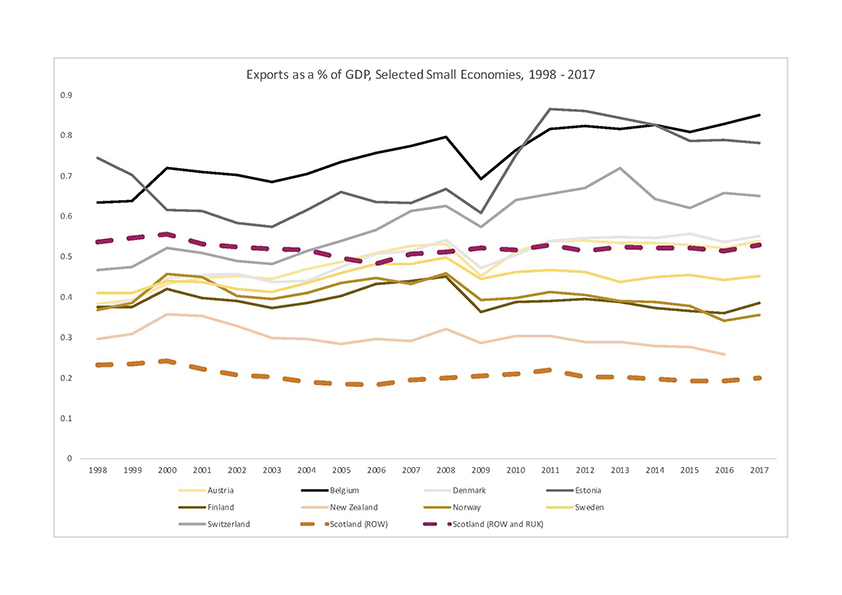
Source: World Bank and Quarterly National Accounts Scotland
Ultimately it’s businesses that will deliver the export growth that will really make a difference to the Scottish economy but the government can play an important enabling role. A Trading Nation sets out the scope and scale of the exporting opportunity available to Scottish business. The plan also seeks to sharpen the focus of the role the public sector and its partners can play in driving exports as part of a wider system of business support.
Through our enterprise agencies, Highland & Islands Enterprise and Scottish Enterprise, we spend around £300mn every year on business support. Of this around £85mn supports international trade and investment promotion and around £30mn of this is for export support. This plan sets an agenda to focus the existing trade support spend and a further £20m over 3 years, as outlined in the 2018 Programme for Government, to where it is likely to offer the greatest return on investment (ROI) to the Scottish taxpayer.
A great deal of valuable work has been done over the years to support Scottish businesses to export. Much of this effort has been focused on growing our exporting base and increasing resilience in our economy. This needs to continue and, at the same time, we need to identify actions that will support the growth of exports as a proportion of our overall economy.
We recognise that Brexit is one of the most significant challenges we face. The Scottish Government’s opposition to it is clear. A Trading Nation was not devised as a direct response to Brexit. However, the plan will help us respond to this challenge by providing a clear understanding of likely future demand for our products and services and setting a clear direction for where we should align our resources. This will enable us to better advise and support our exporters in light of Brexit and other competitive challenges.
Ensuring that the rest of the world is aware of the innovative, high quality and globally competitive products and services that Scotland has to offer has never been more critical.
The scope of the plan
A Trading Nation sets a direction on how best to grow Scotland’s exports and how to best focus resources and policies to deliver that growth. It uses data driven analysis and market intelligence to identify the priority sectors, markets and types of businesses most likely to deliver export growth.
We will work with partners to deliver the actions set out in this plan. These include business organisations and networks, industry groups, the Scottish diaspora, universities, local authorities, UK government agencies and other bodies. A Trading Nation builds on existing economic strategies and the work of the Enterprise and Skills Strategic Board. The plan will be a live document to be updated and developed on a regular basis as situations change and more evidence becomes available. This will also enable us to review and refine the actions and interventions that we make to ensure that they are delivering for businesses and for Scotland’s economy.
Evidence based and co-produced
A Trading Nation is built on an unprecedented level of robust analytical data. More than 20 data sets were interrogated to build our understanding of current and future export growth opportunities. We analysed current and future global import demand in 100 countries across 66 industrial and 19 service sectors. Analytical work was also undertaken to examine key exporting businesses to understand their strengths, size, location, workforce, products and services.
This analysis was shared and tested in a comprehensive consultation exercise with a large number of key business partners and stakeholders to ensure the conclusions drawn reflected their real world experience.
Based on this work, the Office of the Chief Economic Adviser (OCEA) has developed new data tools for the exporting community that are a step change in our export intelligence. They include:
- Scotland’s Export Performance Monitor, comprising detailed data analysis interrogating our recent export history and trends is now published in a user friendly digital format.
- The export value gap tool which benchmarks our export performance in market-sector combinations against competitor countries to better understand where our exports are performing well against our peers and where opportunities for growth exist. We plan to make this data available to our enterprise agencies and their clients as part of their toolkit to support exporters.
Strategic choices: what, where, who and how?
A Trading Nation strives to find answers to four key questions.
- What are the export strengths we should promote?
- Where should we promote these strengths and when should we step up our presence in these markets?
- Who should we work with most intensively to boost our export performance?
- How do we best configure government and wider support to deliver our export goals?
Making these choices was not easy. Should we play to our current export strengths or should we put more effort into developing emerging products? Should we promote our exports to established markets of today or put more effort into emerging markets of tomorrow? When should we step up our presence in overseas markets and which are the businesses that we should work with most intensively to boost Scotland’s exports? Should we work with established exporters or concentrate on creating new exporters and what is the right balance between government direct support and using partners at home and in-market?
We believe the approach set out below offers the best prospects for boosting exports for the benefit of our wider economy.
What export strengths should we focus our promotion efforts on?
Evidence(1) suggests that successful exporting countries specialise in a limited range of goods and services and make the overwhelming amount of their exports earnings selling to a limited number of countries. This partly reflects countries specialising in what they can produce most efficiently. It also partly reflects the reductions in cost that can be achieved through scaling up production, through so called ‘economies of scale’. In addition, clustering of similar firms can result in positive networking and knowledge-sharing effects that help to drive innovation and greater efficiency of production.
This pattern of trade is repeated throughout the world and Scotland is no exception with our top 5 sectors accounting for 69% of our export value. Our export sectoral strengths are in: food & drink; engineering services & manufacturing; life & chemical sciences; technology, digital & media; financial & business services and energy.
Tourism, education and the creative industries are also significant contributors to our economy, in particular through the innate value they add to Scotland’s overarching offer.
Where are the export markets to target for “today” and for “tomorrow”
Where a business chooses to export is a commercial decision for them but, from a public sector perspective, we need to align our export support resources to where we think they will have the most impact. Through the work we have done we have estimated that over 68% of future opportunities to grow Scotland’s exports are in 15 countries, with 80% of our strongest export growth opportunities in just 26 countries. These markets are predominately in Europe, North America and a small number of emerging markets. This plan takes into account not just the current value of exports to these markets but, importantly, blends that with a multi-dimensional view of how global exports to those markets will develop in Scotland’s strongest sectors.
Priority markets – immediate opportunities in multiple sectors
| Export Priority Rank |
Country |
Share of Current Exports |
Share of export value gap |
| 1 |
USA |
17.1% |
10.7% |
| 2 |
Germany |
7.2% |
13.7% |
| 3 |
France |
7.5% |
6.5% |
| 4 |
Netherlands |
7.6% |
7.8% |
| 5 |
Switzerland |
2.3% |
3.1% |
| 6 |
Norway |
3.1% |
3.4% |
| 7 |
Poland |
1.2% |
3.8% |
| 8 |
Belgium |
3.1% |
3.2% |
| 9 |
China |
1.9% |
2.7% |
| 10 |
Ireland |
4.5% |
1.9% |
| 11 |
Denmark |
2.7% |
1.9% |
| 12 |
Sweden |
1.8% |
3.0% |
| 13 |
Italy |
2.3% |
3.5% |
| 14 |
Canada |
1.8% |
1.2% |
| 15 |
Spain |
2.6% |
2.2% |
Source: Export Statistics Scotland and OCEA calculations
Markets of Interest – specific sectoral opportunities in the mid to long term
| Export Priority Rank |
Country |
Share of Current Exports |
Share of export value gap |
| 16 |
Japan |
1.6% |
2.2% |
| 17 |
Australia |
2.2% |
1.6% |
| 18 |
Turkey |
0.5% |
0.8% |
| 19 |
Mexico |
0.5% |
1.0% |
| 20 |
India |
0.7% |
1.7% |
| 21 |
Singapore |
2.0% |
0.5% |
| 22 |
UAE |
2.0% |
0.1% |
| 23 |
Nigeria |
1.0% |
0.2% |
| 24 |
South Korea |
1.0% |
2.0% |
| 25 |
Brazil |
2.2% |
0.5% |
| 26 |
Indonesia |
0.2% |
0.2% |
Source: Export Statistics Scotland and OCEA calculations
As demonstrated in the matrix below, these 15 markets offer strong demand across a range of sectors, with the prospect of business wins in the near term. The next 11 markets also offer good export opportunities, albeit across a narrower range of sectors, and we anticipate good prospects for export wins. No specific sectors are identified in Indonesia but there are general opportunities for the future to be gained here.
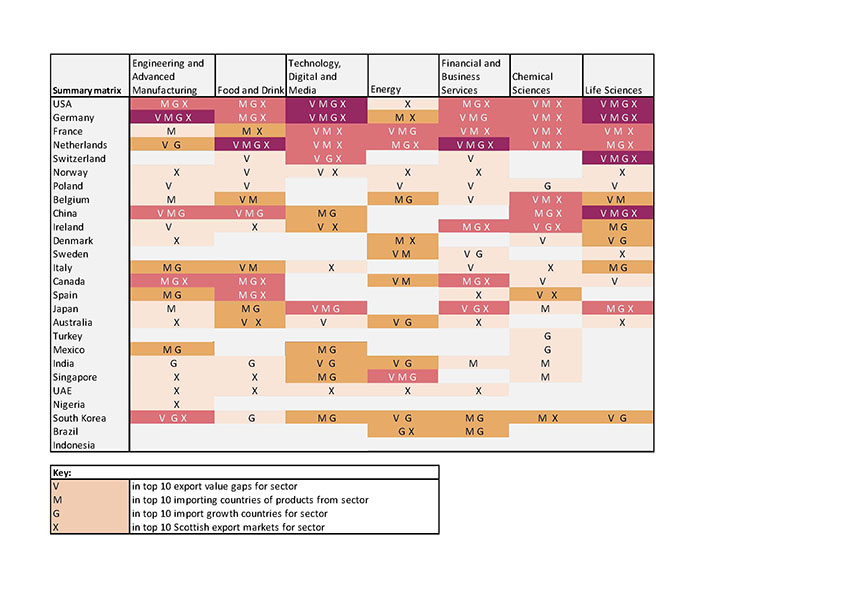 Source: OCEA calculations based on Export Statistics Scotland and UN Comtrade data
Source: OCEA calculations based on Export Statistics Scotland and UN Comtrade data
Who: the businesses that can boost our exports most
As illustrated below, of the 346,000 businesses in Scotland only 11,000 of them export. Of those that export, 100 businesses account for around 60% of our exports. The next 400 businesses account for around a further 20% of exports with the rest (around 10,500) accounting for the remaining 20%. We have looked at similar small developed economies and this profile is typical.
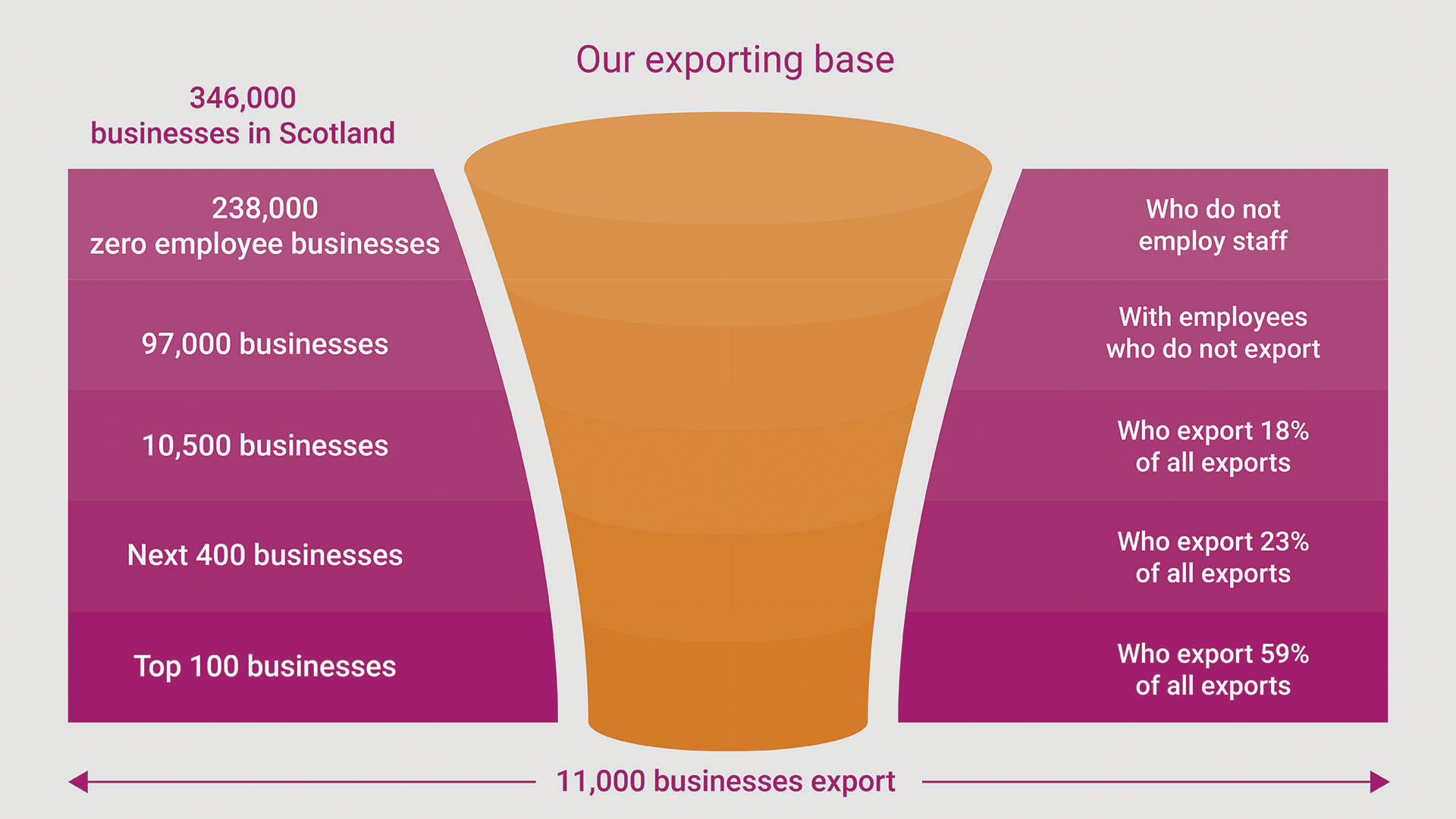
Increasing the exports of the 500 businesses responsible for 80% of our exports by 50% would increase overall exports by £13bn. By contrast, increasing the exports of the other 10,500 by 50% would only increase exports by £2.9bn. If we want to help Scotland’s businesses succeed internationally and drive the growth of exports, the Scottish Government and its enterprise agencies will need to dial up and develop bespoke support for these businesses. At the same time, we must ensure that the right products and services continue be available to support the broader pipeline of businesses.
We need to continue our programmes to assist new and inexperienced exporters, to help grow the exporting base and to make best use of new technology to deliver these services in different, less resource intensive ways. We also need to work with a range of partners to deliver existing business support services. This means that our expert international trade advisers will spend the balance of their time with those businesses whose growth can disproportionately benefit our export performance and the wider economy. We believe this approach will help ensure businesses get the advice and support that best meets their needs.
Working in the same way with all our exporters, or potential exporters, would not make best use of resources or represent good value for the taxpayer. Many of the top exporting businesses will need little or no support, however, they will be able to provide advice and support to businesses that export less than them and also be able to work with their supply chain to help them internationalise.
Many other businesses have the potential to deliver significant increases in their exports, enough to shift the dial on Scotland’s overall export performance. They will need intensive and holistic support to realise their potential.
To cater for these differing needs in the most resource effective way, whilst maintaining our focus on overall export performance, we will implement a segmentation strategy which provides focused support to different types of businesses depending on their export profile.
We will deliver this export support through smart segmentation of businesses based on their distinct characteristics, with a focused plan of support tailored to each of the 5 segments.
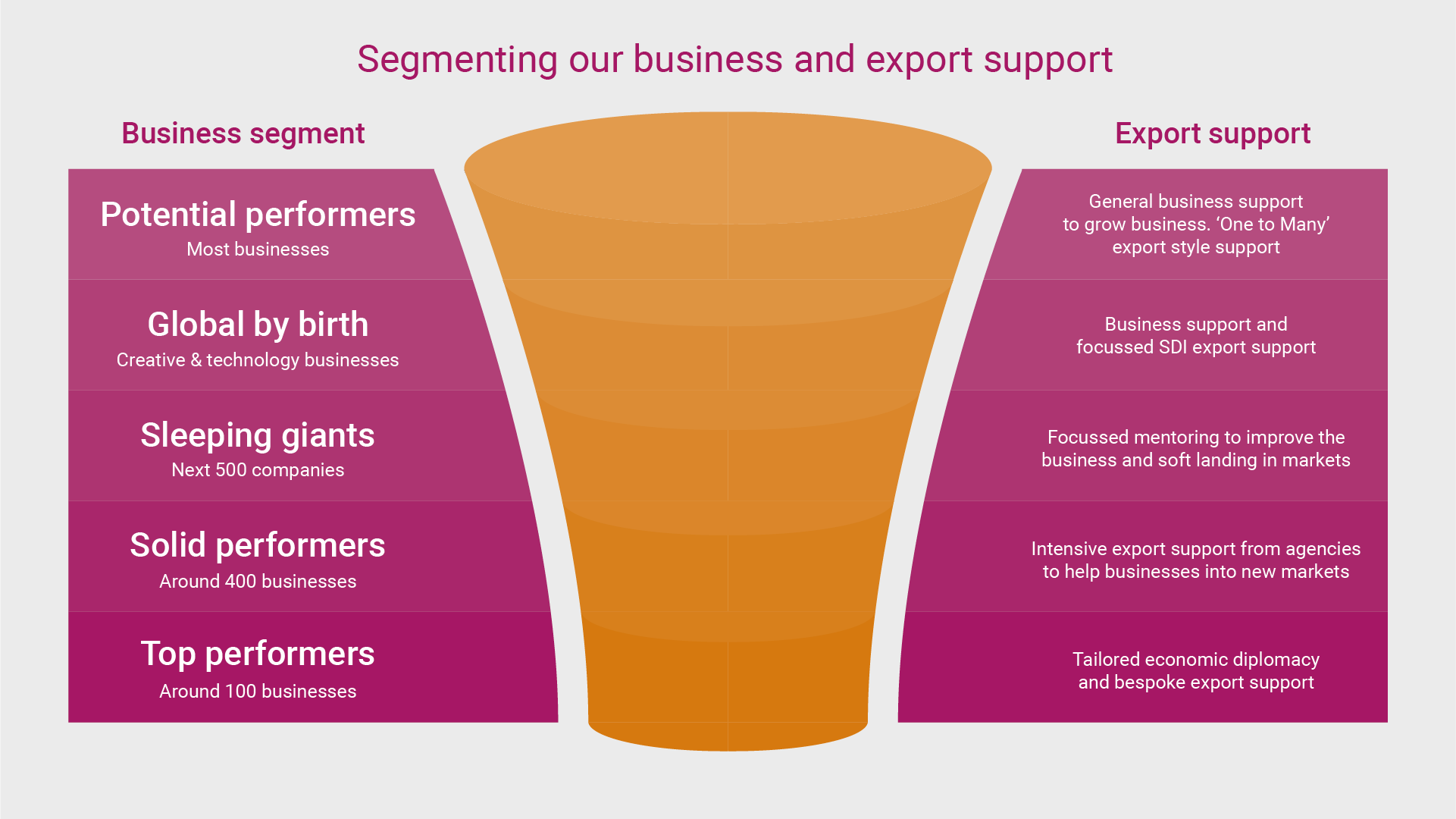
Our top 100 performing exporters are typically global businesses that are unlikely to need export support services but may require “economic diplomacy” support in the form of political intelligence, introductions and advice to exploit opportunities in new markets. We will encourage them to mentor other firms and we will seek to understand their requirements, in particular where we can support them to further embed their supply chains in Scotland or to consider further investment.
Our solid performers, which are predominately SMEs, may have limited internal resources and are likely to need a blend of intensive export support services and, where needed, economic diplomacy interventions.
Our sleeping giants are businesses which have a solid performance of selling into the Scottish or rUK markets, in sectors where their products are likely to be in demand internationally and are of a scale where they have the management bandwidth to support export activity. As fledgling exporters they will need access to business support services to grow their business, innovate their products and when a strong opportunity arises, access to export support. We will also seek to provide focused mentoring support.
Global by birth are typically small businesses in sectors which, by their nature, are global in outlook, for example, in the technology or creative sectors. These businesses need to be treated differently as they are often internationally focused from the outset. They will often already be on enterprise agency scale-up programmes. Given this, we propose they have access to enterprise agency business support services and export support services as needed.
Potential performers refers to the majority of businesses that are already exporting, or aspire to, but typically at a smaller scale. For these businesses existing support services are in place to grow their business, supplemented by export support services (most likely delivered by partners such as Chambers of Commerce) delivered in a “one to many” format such as workshops and (self-help) digital services. The Local Export Partnership pilots led by Chambers of Commerce, with regional partners, including local authorities, is undergoing evaluation and the results of that will feed into our development of future export support services for these businesses.
How: getting the best from a One Scotland approach
Collaborating to deliver the One Scotland approach are the Scottish Government, enterprise agencies and agencies supporting education, tourism and specific industrial sectors.
We also have an international footprint, including 30 SDI offices in 20 countries, including Scotland Europa sitting alongside the Scottish Government in Brussels, and Scottish Government offices in eight countries. VisitScotland also has offices in London and Toronto. This network gives us a range of diplomatic relationships and trade and investment specialists across the globe.
Beyond these government networks we can call on the wider support of the Scottish diaspora, including alumni, GlobalScots, Trade Envoys, Chambers of Commerce and the extensive networks of the British Council and the UK government’s Department for International Trade (DIT), Her Majesty’s Trade Commissioners (HMTCs) and the Foreign and Commonwealth Office (FCO). All of these will be valuable partners in advancing our export agenda. The chart below illustrates our networks and the chart in the following section indicates how each partner can help our exporters.
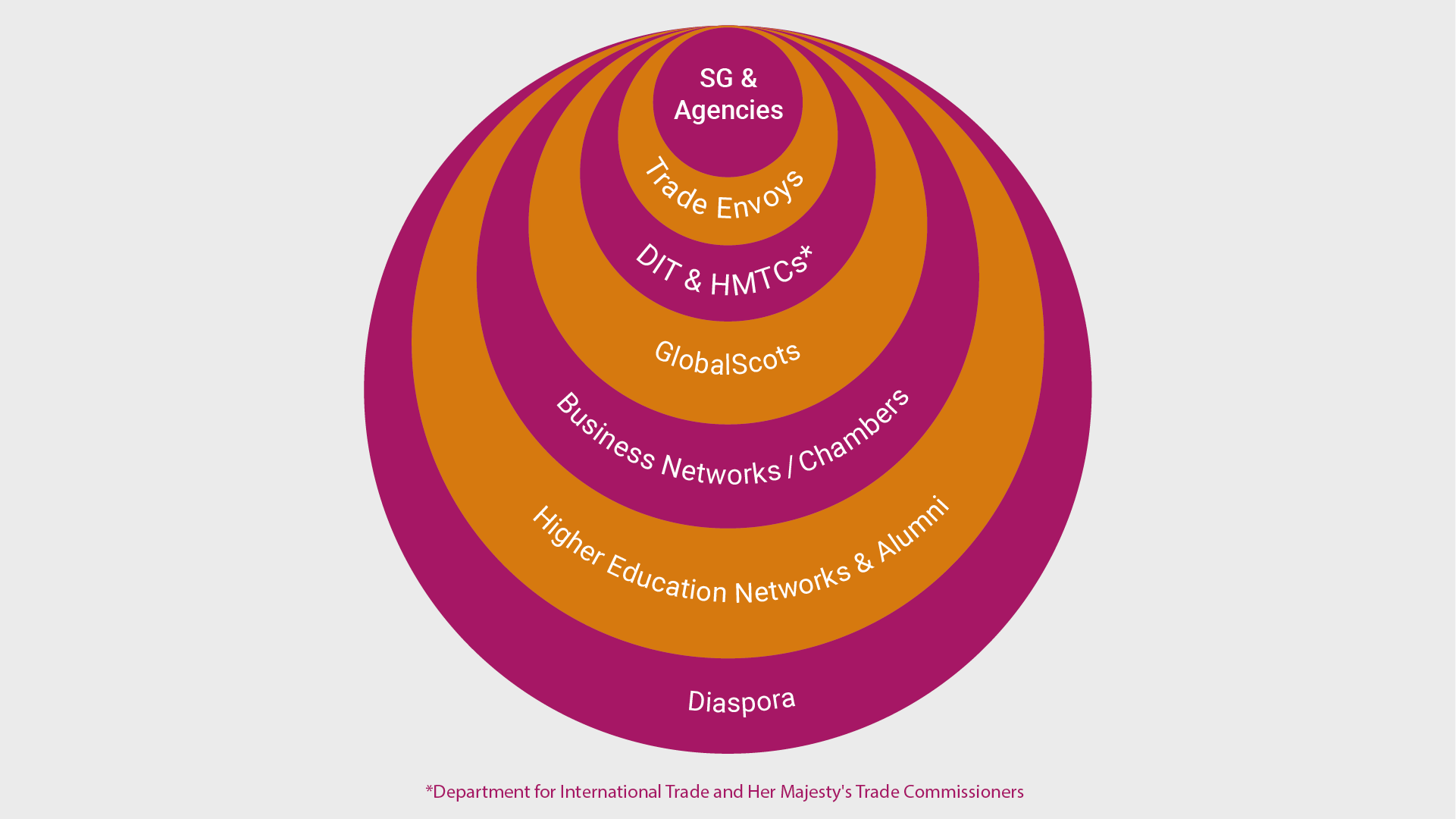
How: aligning export support to market demands and business needs
The Scottish Government, Scottish Development International, our enterprise agencies and delivery partners will need to realign resources and tailor services to meet the needs of exporters based on the analysis that underpins this plan.
The export support needs of a business will differ depending on their level of experience and on how developed, well regulated and transparent their target market is. Well developed markets tend to be stable and have high levels of regulatory predictability that make it easier for businesses to obtain market information and meet relevant contacts. This is not always the case in emerging markets.
Less experienced exporters often require more traditional export support services, such as basic market research provided by agencies or private sector providers, and introductions provided by Chambers of Commerce, GlobalScots and other networks. More experienced exporters are often more self-reliant and generally need different types of export support such as political intelligence and, if required, economic diplomacy or ministerial interventions.
The Scottish Government, SDI and our partners will tailor our services and export support to Scottish businesses dependent on need, as the chart below illustrates.
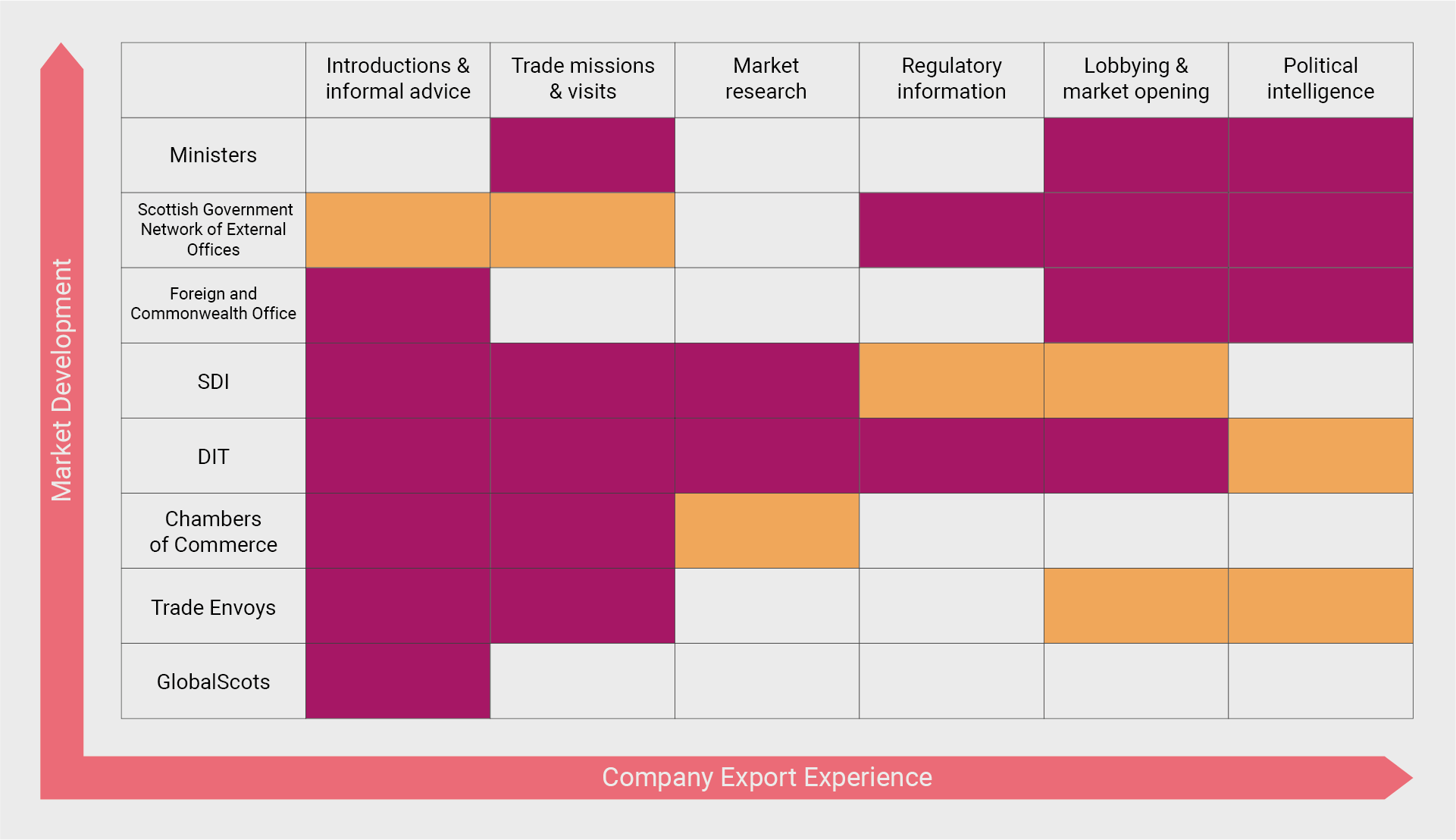
Given the strong opportunities in our priority markets, we will strengthen and realign our export resource to target key growth sectors within the 15 priority markets and the 11 markets of interest. We will also strengthen our GlobalScot networks in these countries and seek to build on the strength of Scotland’s alumni network and the wider Scottish diaspora.
We recognise that there are opportunities for Scottish businesses in other emerging markets and we will continue to monitor them closely and scale up our in-market support as required.
Wider considerations
In addition to the strategic choices above, the plan also includes analysis on other issues of critical importance to our export drive, including connectivity to markets by air and through our ports, issues around export finance, how we use set piece events like Dubai Expo and opportunities to further leverage the One Scotland delivery model to support our export performance. We also highlight Scotland’s place as a ‘good global citizen’ with respect to wider considerations, including human rights and the environment.
Key actions
In collaboration with Scottish Development International, our enterprise agencies and other delivery partners we have identified a number of strategic decisions and policy actions that, when delivered in concert, will help adjust our export support ecosystem to better boost export performance and grow the economy.
Actions in the plan are a combination of those delivered in Scotland to increase awareness of export opportunities and to raise the level of ambition across the business base to improve export performance, as well as measures to ensure that businesses have the capacity and capability to capitalise on the opportunities identified in the plan. These measures are complemented by actions in-market to ensure that the right support is available to enable Scottish based businesses to expand and exploit these opportunities. As this is a live plan, we will continue to monitor, evaluate and adjust the actions to ensure that we are providing the most effective support possible.
Actions to scale up trade promotion and Scotland’s overseas reach & profile
1. Scale up the GlobalScot network, expanding from 600 to 2000 business people in key markets, including doubling to 500 in Europe by 2020 with clearer “asks” and “offers” of support from a revamped SDI support platform.
2. Enrolling our leading exporters in growing a world-class brand Scotland to support all exporters as part of Scotland is Now.
3. Scale up our trade promotion activity with an expanded international missions and exhibitions programme building on SDI’s current 68 global events and the Chambers’ international programme and at major international events, including the Rugby World Cup 2019, Dubai 2020 and the Tattoo in China 2020.
4. Strengthen our network of overseas in-market specialists by adding up to 15 in-market specialists focused on the 15 countries that make up two thirds of our export opportunities and in the sectors that offer the “best bets” for growth.
5. Twelve of our priority markets are in Europe so we will continue to do all that we can to remain in the EU or, as a minimum, remain in the Single Market and Customs Union.
Actions in Scotland to ramp-up our support for firms’ export capacity
Restructure and refocus Scottish Development International to:
1. Separate into specialist divisions for export and investment attraction work building on a successful pilot in the food & drink sector.
2. Shift the bulk of its resource into priority markets that offer the biggest opportunities for Scotland’s sectoral strengths by reorganising SDI’s footprint to capitalise on priority markets.
3. Focus on growing existing exporters (by diversifying into new markets or new products) and high potential early stage firms (in industries like digital and life sciences).
4. Develop new support to help more ‘global by birth’ businesses scale up rapidly.
5. Integrate SDI more closely with enterprise agencies to help more domestic businesses graduate to exporting.
6. Continue to work with Chambers, Business Gateway, sector leadership bodies and others to grow new exporters.
7. Increase the digital offer of training, advice and resources through the new enterprise agencies’ “single access portal”.
8. Boost the skills of relevant businesses through export qualifications helping to deliver a step change in sales and marketing skills.
9. Expand the reach of business networks, including up to £2m for the Chambers of Commerce for a number of trade missions over 3 years and support the Scottish Business Network to exploit trade opportunities from London.
Monitoring and evaluation
At the heart of this plan is the need to increase exports as a percentage of GDP. We will set a target of increasing exports to 25% of our GDP by 2029. Meeting this target will require around a further £25bn of exports by 2029. The economic impact of meeting this target would be to add around £3.5bn to GDP and to create around 17,500 more jobs with an increase in annual tax take of around £500m(2).
To understand whether we are making progress against this target there are a number of indicators that we will monitor. We will develop a monitoring framework that will track key performance indicators, including the overall value of exports, the value of exports to particular countries, the value of exports from particular sectors, the value of exports from specific businesses and the number of exporters. We will regularly evaluate our actions to ensure that we continue to focus on those measures that are delivering results.
References:
(2) Cash figures are presented in 2016 prices.